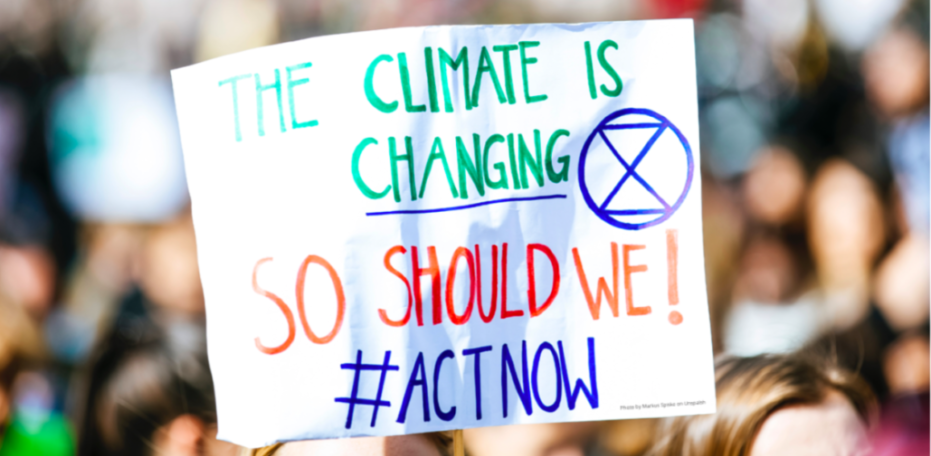
We are faced with an uncertain future that threatens the fabric of not just human civilization but that of the planet as well. Climate change and increased divisive politics are tearing us apart, now more than ever. We are all aspiring for a world where we can breathe clean air, drink clean water, have equal access to Earth’s natural resources and opportunities as a society. So how can we come together as a group to conquer these challenges?
In October, thousands of higher education sustainability professionals gathered together to explore the theme “The future is” at the Global Conference on Sustainability in Higher Education. Conversations centered around net-zero carbon emissions continued the following month at the United Nations Climate Change Conference where accelerated measures to halt fossil fuel subsidies were discussed. Yet, it became abundantly clear through the vocal sustainability community that more needs to be done to address the already devastating impacts of climate change.
Soon after, the U.S. Environmental Protection Agency announced a bold new strategy to reduce the climate impacts of production, consumption, use and disposal of materials, which account for 50% of the global greenhouse gas emissions by bolstering the recycling infrastructure with a new goal of reaching a 50% recycling rate nationwide by 2030. This is part of a broader strategy on “Building a Circular Economy for All”. In addition to boosting the recycling infrastructure necessary to reach this goal, this plan also places emphasis on providing equitable access for overburdened communities located close to waste facilities, reducing environmental impacts and stimulating economic development in those communities. This new goal is in line with President Biden’s commitment to achieving a 50-52% reduction in greenhouse gas emissions from 2005 levels by 2030.
Many states have already passed several waste and recycling bills this year, stemming from public concern and political pressure, from California pushing through its backlog of circular economy bills to Maine signing the first-ever EPR (Extended Producer Responsibility) law for consumer packaging.
Local municipalities are also taking action toward zero waste. Recently, the city of San Francisco’s Department of Environment launched a Zero Waste Grant Program. The mission was to advance climate protection and enhance the quality of life for all San Franciscans. One of the recipients of the award was University of California, San Francisco (UCSF), who, in a joint collaboration with Zabble, proposed to reduce 33 tons from entering landfills over the course of 6 months (from December 2020 – May 2021) by employing manual sorting aided by technology to inform upstream educational campaigns.
The Project
The UCSF and Zabble project team identified the following 6 steps to run zero waste campaigns. A zero waste campaign is a time-bound, measured effort that has an objective goal of reducing contamination, increasing landfill recovery or reducing waste generation. The steps are:
1. Establish a Task Force – The project team was comprised of UCSF’s Waste Reduction and Recycling Facilities staff, a sorting crew staffed by Envirolutions and Zabble’s project managers. The members of the task force were responsible for communicating on the workflow and typical issues during normal operations like missed pickups, or hazardous or e-waste incidents. They also had to drive outcomes by engaging specific departments within UCSF to accommodate requests such as putting up signage or attending in-training sessions. The task force participated in regular monthly meetings to keep tabs on progress and respond to issues.
2. Identify a Hypothesis – A hypothesis is a mutually decided upon a goal or an assumption that requires evidence and is a key objective of the project. For a hypothesis to be effective, all the stakeholders have to agree on it before the project begins. Our hypothesis was to “Recover 33 Tons from Landfill and engage stakeholders in 6 months.”
3. 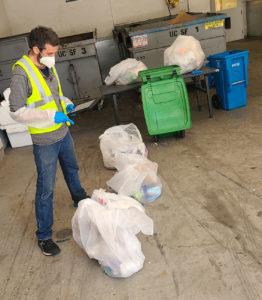 Measurement System – A good zero waste campaign needs a valid measurement system so the results can be trustworthy and repeatable. Our system had the following elements:
Measurement System – A good zero waste campaign needs a valid measurement system so the results can be trustworthy and repeatable. Our system had the following elements:
- Sample 10 landfill bags every day
- Tag fullness and contamination %
- Sort the contents of the bags into different streams
- Observe contaminants and document their source
- Tag the fullness of the post-sort containers (landfill, recycle, compost)
For this project, the UCSF staff and sorting crew used the Zabble Zero™ Mobile Tagging application that uses AI to classify the fullness of bags, bins, carts and dumpsters and suggests contamination items depending on the stream to accurately tag contamination items for targeted upstream outreach. The application also immediately notifies the right personnel when e-waste, hazardous waste or other incidents are identified in any of the bags or dumpsters so they could immediately fix the problem. This significantly reduced the time it would have taken the crew to document their daily observation on pen and paper or routinely conduct waste characterization audits.
4. Define KPIs – To help us keep track of progress towards our goals, we had agreed to a set of Key Performance Indicators (KPIs).
- Primary KPIs:
- Pre-sort Diversion %
- Contamination %
- Post-sort Diversion %
- Secondary KPIs:
- Incidents Resolved
- Outreach Activities
5. 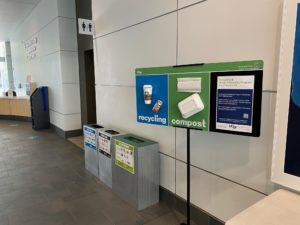 Engage Stakeholders – Once we had a steady stream of reliable data, we needed to derive actionable insights to engage stakeholders with and implement changes to positively affect behavior towards reducing contamination. The Zabble Zero™ web dashboard aggregated all the KPIs on a per building basis and presented the top contamination items for targeted outreach. We set up a periodic cadence to communicate KPIs with all stakeholders through meetings or emails and shared resources like signage for outreach.
Engage Stakeholders – Once we had a steady stream of reliable data, we needed to derive actionable insights to engage stakeholders with and implement changes to positively affect behavior towards reducing contamination. The Zabble Zero™ web dashboard aggregated all the KPIs on a per building basis and presented the top contamination items for targeted outreach. We set up a periodic cadence to communicate KPIs with all stakeholders through meetings or emails and shared resources like signage for outreach.
6. Close the Loop – Finally, we repeated steps 1 through 5 to close the loop and continuously improve processes that resulted in reducing contamination, increasing diversion from landfills and finding opportunities for waste reduction.
Results
We started the project in December 2020 when there was an uptick in COVID-19 cases over the holidays and that presented some staffing challenges. The staff had a ramp-up time of a month to reach a state of reliable data collection. By the end of February 2021, we had a clear idea of our first outreach effort. The top contaminator in the landfill stream was paper towels followed by napkins, plastic bottles, food waste, animal bedding and recyclable bags, containers and paper cups. 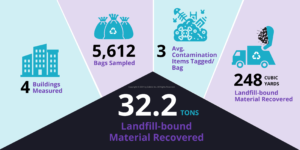 On further deep dive, it was found that a few bags containing paper towels were appearing from restrooms, but a large portion of those bags were from labs when looking at other contaminants (ex: pipettes) that were co-located in those bags. This gave us enough evidence to post specific signage for paper towels in restrooms and communicate to lab managers about this issue. Apart from this, we were also able to post signage in each of the 4 buildings’ lobby areas targeting the top contamination items.
On further deep dive, it was found that a few bags containing paper towels were appearing from restrooms, but a large portion of those bags were from labs when looking at other contaminants (ex: pipettes) that were co-located in those bags. This gave us enough evidence to post specific signage for paper towels in restrooms and communicate to lab managers about this issue. Apart from this, we were also able to post signage in each of the 4 buildings’ lobby areas targeting the top contamination items.
These interventions were conducted twice during the 6 month period, in February and April 2021. 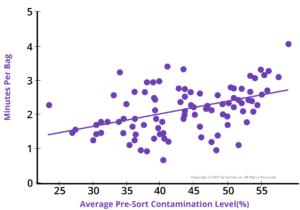 The following months showed a clear reduction in the number of bags containing paper towels and the number of paper towels in those bags. Overall, the project succeeded in recovering 32.2 tons of material from entering landfills.
The following months showed a clear reduction in the number of bags containing paper towels and the number of paper towels in those bags. Overall, the project succeeded in recovering 32.2 tons of material from entering landfills.
Intuitively, we know that higher contamination leads to a longer sorting time. Through our analysis, we found that a 20% increase in contamination added 1 minute to the sorting time, or 44 hours of sorting time each month for the duration of this project.
Conclusion
Despite the COVID-19 pandemic presenting itself in staffing challenges and workforce inconsistency, the combined effort proved fruitful. The sampling methodology and the 6-step strategy were executed efficiently, and were effective at collecting great data resulting in actionable insights. When applied towards targeted outreach to reduce paper towel contamination in the landfill stream, it was found to be effective as bags with only paper towels dropped by 7% on average after each intervention.
This project showcased a successful joint collaboration among a municipality, a university and a private entity as a powerful way to address key environmental problems such as sending less waste to landfills, boosting recycling by sending cleaner material downstream and educating stakeholders.
So it now comes down to new ideas and strategies to build a climate-resilient future with everyone in mind. The future is defined by us, now.
For more information about the details of the project, its outcome or Zabble’s technology platform, contact the Zabble team here.
About the Author
Nik’s foray into the waste industry was triggered by the excessive amounts of waste in the environment. He founded Zabble Inc. in 2016 to build a cloud-based platform to help large organizations achieve zero waste. He is a TRUE Zero Waste Advisor and former board member of the Northern California Recycling Association (NCRA) who actively participates in local beach cleanups and zero waste advocacy. His passion for hiking and open water swimming is a constant reminder to keep trash out of the environment.